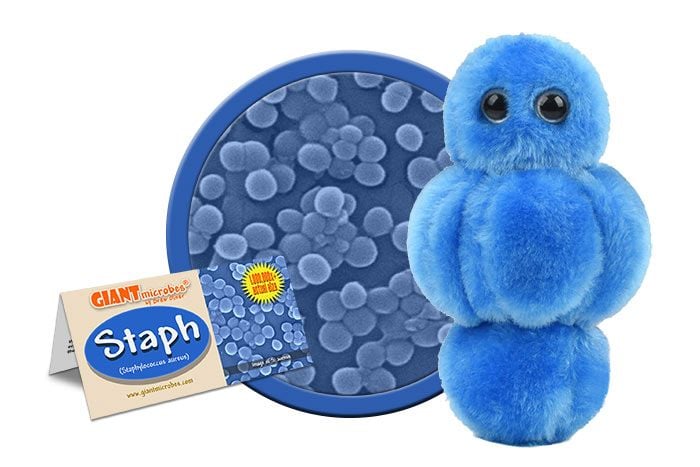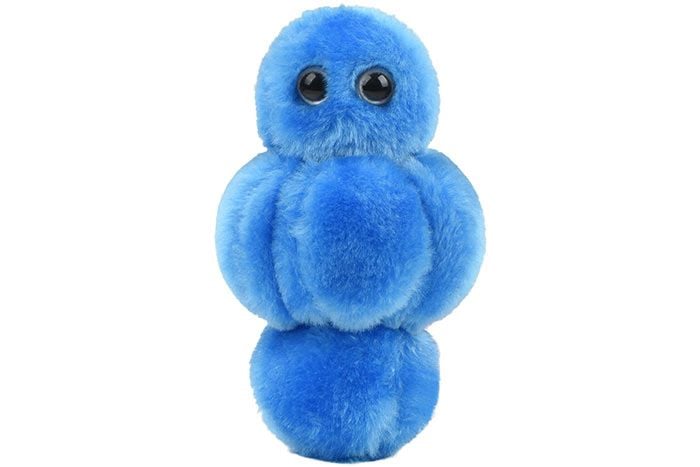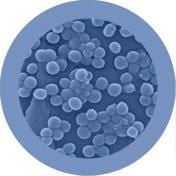Staph (Staphylococcus aureus)
Out of Stock
Product Details
Additional Information
| Sizes | Giantmicrobes are based on actual microbes, cells, organisms and other critters, only 1,000,000 times actual size! Gigantic (GG) 40-60cm XL (XL) 25-38cm Original (PD) 12-20cm Minis (MM) 5-10cm each Keychain (KC) 5-10cm with clip |
|---|---|
| Materials | Plush from all new materials. Stuffed with polyester fiber fill. Surface washable: sponge with water & soap, air dry. |
| Packaging | Each plush microbe includes a printed card with fun, educational and fascinating facts about the actual microbe or cell. |
| Safety | Every product meets or exceeds U.S. and European standards for safety. For ages 3 and up. |
All about Staph (Staphylococcus aureus)
FACTS: There are over 30 different kinds of staph bacteria, but staphylococcus aureus is the most common. (Staph, or staphyle, means “bunch of grapes” in Greek, which is more or less what staph looks likes under the microscope.)
It can often be found living harmlessly on human skin. But occasionally, staph will wander into a hair follicle or slip into a crack in your skin causing a slew of common infections ranging from boils, to sties, to rashes. Red sores and pus are typical of affected areas.
Because these types of infections are normally localized and minor, washing with antibacterial ointment is usually sufficient treatment. And in many cases, staph infections clear up on their own.
But it is important to monitor infected areas and keep them clean. If staph penetrates further into your body, or gets into your bloodstream, it can cause serious ailments such as “food poisoning”, pneumonia, Toxic Shock Syndrome (TSS), and even septicemia.
In addition, patients undergoing surgery are at significantly increased risk for infection, not only because their skin-barrier is compromised, but also because their immune systems are typically suppressed.
Which is one reason hospitals try to maintain as sterile an environment as possible: infecting patients with staph after curing them is clinically-proven to reap sour grapes.
| Name | Staphylococcus comes from the Greek: staphyle = bunch of grapes, and kokkos = berry, for its appearance under a microscope. Aureus comes from the Latin: aurum = gold, because of the color of the colonies. |
|---|
| Where It Lives | Contact with an infection or something that has recently touched an infection. Fun gift for a doctor or nurse! |
|---|
| Symptoms | It can cause boils, food poisoning, or toxic shock syndrome. Skin infections are typically shown as a pus-filled sore. Internally, it can cause fever and low blood pressure. If infections progress, there are dangerous and potentially fatal effects. |
|---|
| Cure | Different antibiotics depending on the type of Staph. Food poisoning typically clears on its own. |
|---|
| History |
1882: Alexander Ogston discovered and named Staphylococcus as the primary cause of pus. 1884: Anton Rosenbach isolated and named Staphylococcus aureus. Big Outbreaks: May 1990: Staph food poisoning at Rhode Island elementary schools. Recent Outbreaks: June 2015: 86 children infected by Staph in daycare food in Montgomery, Al. July 2012: >60 people at a homeless shelter in Denver got food poisoning from Staph. |
|---|
| Fascinating Facts |
Found naturally on the nose and skin of about 1/3 of healthy people. Staph can live through temperature, humidity, and salt extremes. Famous People Who Have Had Staph: Roy Scheider, from Jaws, died with Sta[h infection complications in 2008. |
|---|












